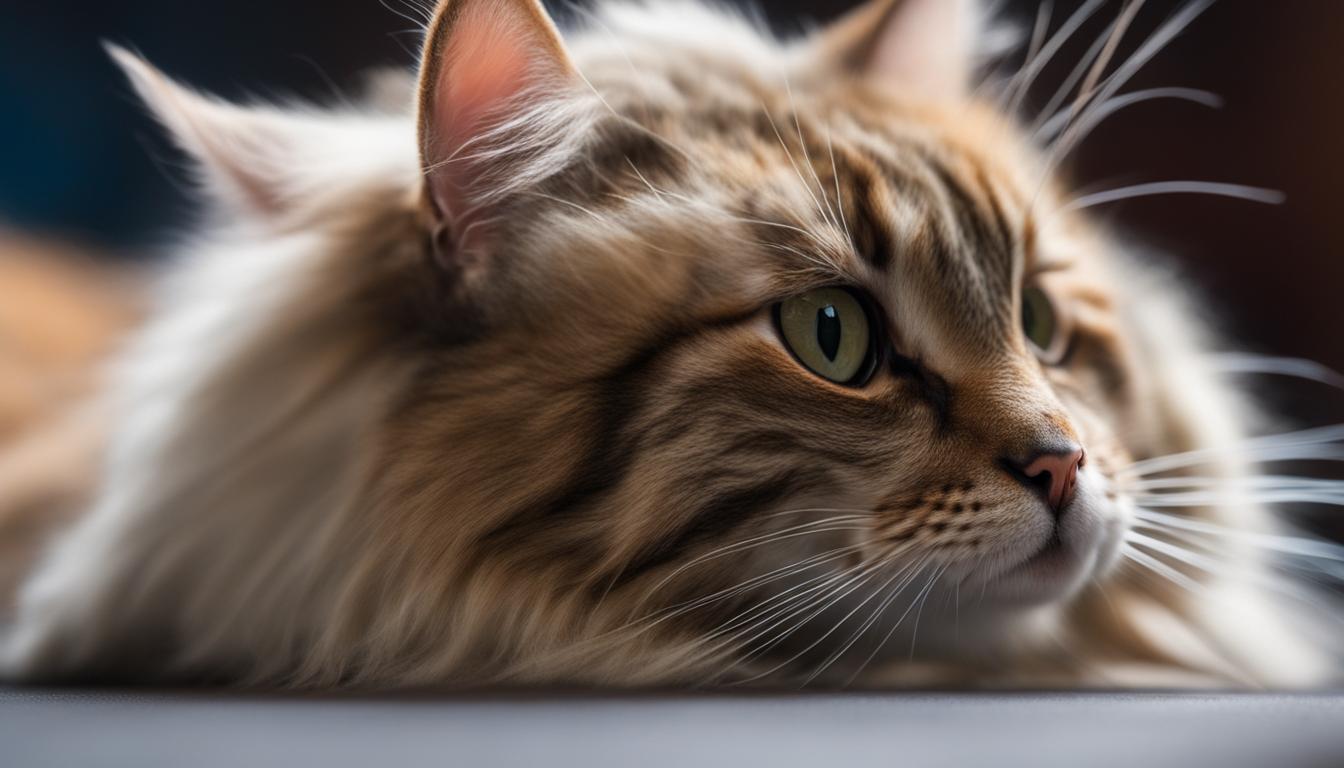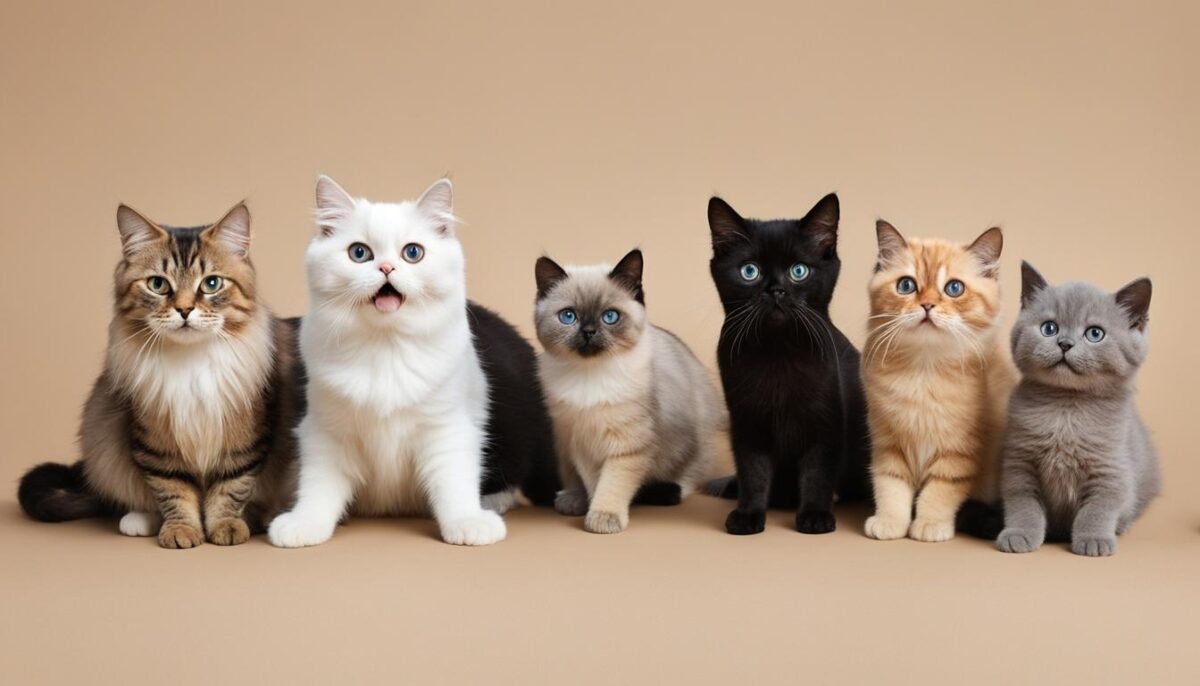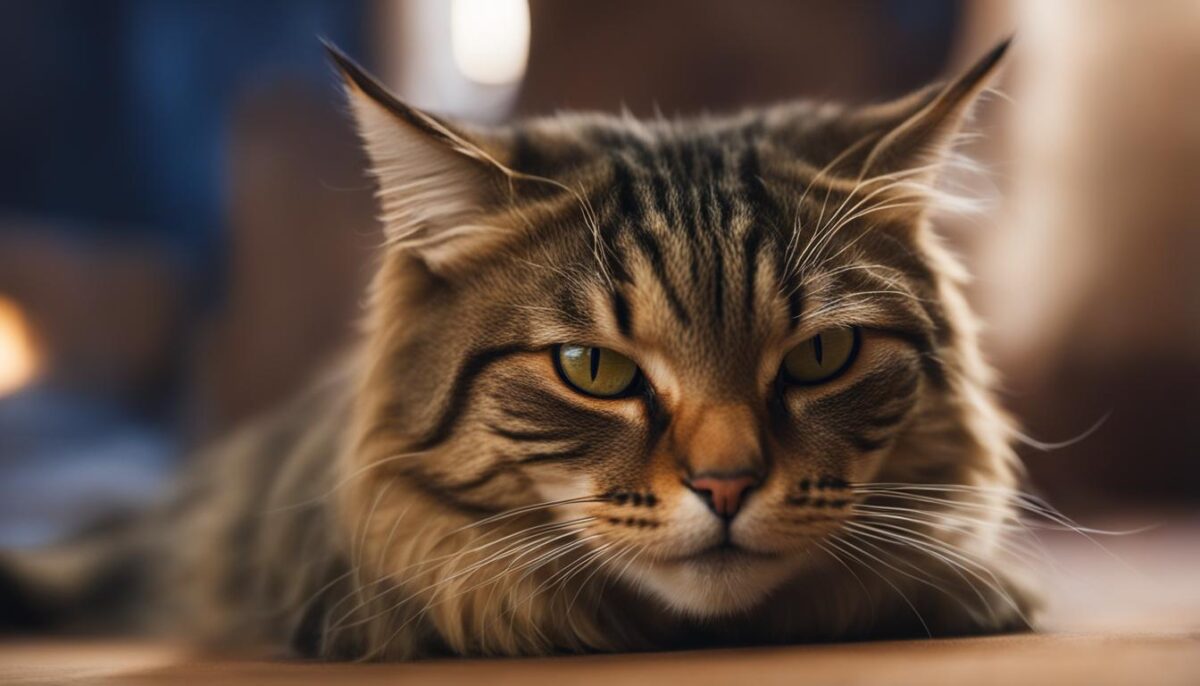Have you ever heard your cat purr in a way that sounds different? Your furry friend talks through purring. Cats make a lot of different sounds. These sounds are a way for your cat to tell you how they feel. Most times, a purr is your cat’s way of saying, “I’m happy to be with you.” But sometimes, purring is more than just happiness. It might mean your cat is not feeling well or is worried about something.
If your cat’s purr is not like it used to be, keep an eye on them. Look at the way they act. Watch for odd signs like hard breathing. When you cuddle your cat and they purr, they are probably happy. But, if they purr and do not seem to relax, they may want you to know they need help.
Key Takeaways
- Purring is a way cats talk to you.
- A change in how they purr may mean something is up.
- Watch how your cat acts when they purr.
- Purring can mean happy, scared, or not feeling good.
- Kitties might need your help if their purr is strange.
Decoding Your Cat’s Vocal Expressions
Have you ever wondered what your feline friend is trying to tell you with those meows and purrs? Cats have their own way of talking, and it’s not just with meows. They might chirp or trill when they’re happy or curious. **Interpreting cat sounds** can be a fun way to understand your pet better.
Cat communication isn’t just about sounds, though. Your kitty’s body language, like their ears and tail, can tell you a lot. For instance, when a cat’s tail wags or their ears go back, they might be annoyed or scared.
Vocal cats, like the talkative Siamese, are known to “speak” more. Some cats get more chatty as they get older, which could mean they need more love or help because they can’t see or hear as well.
Let’s learn what different cat sounds might mean:
- Meow – A classic sound for “Hey, look at me!” or “I’m hungry.”
- Chirp – Cats often make this bird-like sound when they’re watching birds or feeling playful.
- Trill – A trill can be a sign of happiness. It’s often used between a mother cat and her kittens.
Understanding **feline behavior** isn’t hard. Just pay attention to the little sounds and moves your cat makes. If you listen and watch, you can get pretty good at knowing what your kitty is saying!
| Cat Sound | Possible Meaning |
|---|---|
| Soft Meow | Happy or Wants Attention |
| Loud Meow | Upset or Hungry |
| Purr | Relaxed or Feeling Good |
| Chirp or Chatter | Excited, especially if watching birds |
| Growl or Hiss | Scared or Wants to Be Alone |
Remember, each cat is special. Your little buddy might make sounds that aren’t on this list, and that’s okay. With time, you’ll get the hang of interpreting cat sounds and be the best cat friend.
How Your Cat’s Breed and Age Affect Vocalization
Do you know that your furry friend’s meows can change with their age and the kind of cat they are? Yes, that’s right! Just like people, cats can act differently because of how old they are and what type they are. Let’s explore what makes some cats chatterboxes and others as quiet as a mouse!
Feisty Felines: Which Breeds Talk More
If you’ve ever heard a Siamese cat, you know some breeds love to talk! These cats along with others like the Bengal and Burmese are known for being very vocal cat breeds. Each type of cat has its own special way of saying hello or asking for a tasty treat. What’s cool is that cat breed characteristics play a big role in how much your cat might chat with you.
From Spirited Kittens to Silent Seniors: Age-Related Vocal Changes
Little kittens are super chatty because they rely on kitten communication to tell their mom and people when they need food or cuddles. But as cats grow up, they often become less vocal. Senior cat behavior is much quieter compared to frisky little kittens. Older cats might meow less because they are more relaxed or sometimes, they don’t hear as well as they used to.
Here’s a neat look at which cat breeds you might hear the most from and how age can hush their purrs and meows:
| Vocal Cat Breed | Chatty Level as Kittens | Chatty Level as Seniors |
|---|---|---|
| Siamese | Very Chatty | Chatty |
| Bengal | Super Chatty | Less Chatty |
| Burmese | Chatty | Less Chatty |
| Persian | Quiet | Very Quiet |
| Maine Coon | Medium Chatty | Less Chatty |
| Ragdoll | Quiet | Very Quiet |
Why Is My Cat Making Weird Purring Noises: Breaking Down the Sound
When your cat’s purring sounds unusual, they may be trying to tell you something with their abnormal cat purring. Those funny noises can mean different things. Maybe your furry friend is super happy or perhaps a little hurt or scared. Let’s figure out why by interpreting cat purring.
Cats can purr for lots of reasons. If they are in pain, purring can help them feel better. It’s like a magic button that releases special chemicals to make the ouchies go away. Imagine purring being a superhero power that helps cats heal when they have boo-boos.
But remember, health-related vocalizations like purring can also mean “I love you” or “My tummy’s rumbling—I need snacks!” It’s a bit like a secret code you get to solve by looking at what your cat is doing when they purr.
Here’s a quick tip on how to tell what your cat’s purrs mean:
- Happy Purr: Your cat looks comfortable and might be snoozing or getting pets.
- Ouch Purr: Your cat doesn’t want to move much and the purring sounds a bit off.
- Attention Purr: Your cat is looking at you a lot, maybe even bumping into you!
| Purring Sound | What It Might Mean | What to Do |
|---|---|---|
| Soft and Smooth | Contentment | Keep giving those good pets! |
| High-Pitched | Something’s Wrong | Check if they need help. |
| Loud and Urgent | Hungry or Wants Attention | Time for play or a snack! |
If your cat’s purring sounds more like a tiny motor than usual, and they look uneasy, that’s when you want to keep an extra close eye on them. They might be saying, “Hey, I don’t feel too great.”
Cats are amazing and understanding their purring can help you make sure they’re happy and healthy. So next time you hear your cat’s purr, think about all the reasons they might be telling you with their purrs.
Understanding Purring: More Than Just Contentment
When you hear a cat purring, it might seem like they’re just happy. But did you know that purring can mean many things? Cats purr for all sorts of reasons, not just when they are feeling cozy and content.
The Dual Nature of Purring: Comfort and Distress
Cats often purr when they are feeling good, and this is known as comfort purring. It’s their special way of saying they feel safe and loved. You might hear these soothing sounds when you’re petting your cat or when they’re all curled up in their favorite spot. However, purring is also a stress indicator in cats. They might purr to help themselves feel better when they are scared or not feeling well.
Purring as a Self-Medicative Behavior
A cat’s purr isn’t just a way to communicate; it can also have healing effects. Yep, it’s true! When your cat is purring, it’s not just a noise. It’s like a little engine inside them that can help make them feel better when they are hurt. Even though you can’t see it, this special rumble can actually help their body recover faster.
Also, your cat’s purr can be a way for them to ask for your attention. For example, when they are hungry, they might purr really loudly to let you know it’s time for a snack. But keep an ear out! If your cat’s purr doesn’t sound right, or they are acting differently, it could be their way of telling you they don’t feel good.
| Type of Purring | Meanings | When to Listen |
|---|---|---|
| Happy Purring | Feeling great, relaxed | During cuddles, resting |
| Hungry Purring | Asking for food | Usually before meal times |
| Healing Purring | Recovering, feeling better | After injury or stress |
| Worried Purring | Feeling nervous or in pain | At the vet, during discomfort |
Remember, your cat has different purrs for different times. Listening to them can help you understand how your furry friend is feeling. It’s super cool how cats have their own way of talking to us!
The Language of Meowing: Communicating Needs and Emotions
When your cat meows, it’s like they’re talking to you. Cats meow for many reasons. Sometimes they want food, sometimes they say hello, and other times they might feel upset. Cat meow interpretation can help you understand what your furry friend feels and needs.
Cat emotions are not a mystery anymore. You can learn what they are trying to say just by listening to their meows. You might notice they have one meow for “I’m hungry,” another for “Let’s play,” and a different one for “I need a cuddle.”
Deciphering the Many Meanings Behind Meows
Meows are not just sounds; they are messages. Does your cat have a soft, happy meow when they see you? Maybe they use a loud, demanding meow when it’s time to eat. Each meow is a clue to what they want.
Chirps, Chatters, and Chirrups: Short-Form Cat Chat
Besides meows, cats make other fun sounds. Have you ever heard your cat chirp when they look out of the window? Or maybe they chatter when they play with a toy. These feline short vocalizations can mean they are excited or just having fun.
| Sound | Meaning | When You Might Hear It |
|---|---|---|
| Meow | I want attention | When you come home |
| Loud Meow | I’m hungry or I want something | Mealtime or when they can’t find you |
| Chirp | Let’s go, follow me | When they want you to go somewhere with them |
| Chatter | This is exciting | When playing with toys or watching birds |
| Purr | I’m happy and relaxed | When petting them or snuggling together |
Next time you hear your cat, listen closely. What are they trying to tell you? Remember, their sounds are their way of talking to us!
Observing Body Language: When Purring Signals Trouble
When your cat purrs, they might be full of joy and feeling just right. Yet sometimes, that soft rumble might be a clue that they are not okay. Cats have their own way of telling us how they feel with cat body language. It’s like a secret talk without words!
Look out for signs, like when they have big, wide eyes or their tail flicks fast. Does your cat hide more than play? Do they skip meals or seem not to sleep well? These could be stressed cat behaviors.
If your kitty is suddenly purring a lot, it’s good to watch them closely. Sometimes, cats purr to help themselves feel better when they’re not well. When they are sick or hurt, cats might make a purring sound to ease the ouch. This is one way how purring and health issues can be linked.
Remember, if your sweet cat seems different or acts like they’re feeling bad, they may need to visit the vet for a check-up. Trust what you see in their body talk and take care to keep them healthy and happy.
Conclusion
As you’ve learned from your furry friend’s sounds, purring isn’t just a happy noise. Sometimes, your cat might purr because they feel sad or hurt. It’s like they are trying to tell you something is wrong. By listening and watching, you can understand your cat’s purrs and give them love and help when they need it.
Sounds of Sorrow: Recognizing Unhappy Purrs
If your cat purrs and doesn’t seem happy or normal, they might not feel good. Check to see if they show signs of sadness or pain, like not playing or eating less. By understanding cat purrs, you can figure out how your cat feels. When your cat makes odd purring sounds, it’s a way they talk to you for help.
Your Role in Understanding and Responding to Odd Purr Sounds
Your job is to care for your cat and find out what their purring means. When you hear a strange purr, watch how your cat acts. Are they moving and eating like they always do? Or are they quiet and alone? Paying attention to these things can help you take care of your cat. When you know your cat well, you can help them feel better and stay healthy. If you think something is not okay, help your cat by seeing the vet. Remember, you are the one who knows your cat the best. So trust what you feel about their purrs. By responding to cat health signs, you’re showing how much you care for your feline friend.
FAQ
Why does my cat’s purring sound odd sometimes?
Your cat’s unusual purring could be an attempt to communicate different feelings or desires, ranging from happiness to pain or even fear. It’s essential to observe the context and their body language to better understand the message they’re trying to convey.
How can I interpret my cat’s different vocal sounds?
Interpreting cat sounds, including meows, chirps, and trills, can give insights into what your cat is feeling or wanting. Factors like their age, breed, and individual personality will influence the sounds they make.
Do certain breeds of cats talk more than others?
Yes, some breeds like Siamese and Abyssinian are known to be more vocal. The level of vocalization can also vary with age, as kittens tend to be noisier to attract attention and care, while senior cats may become quieter over time.
What could be the reason my cat is making weird purring noises?
Weird purring noises might indicate health-related issues, discomfort, or your cat’s unique way of expressing various needs or emotions such as hunger, excitement, or anxiety.
Is purring always a sign that my cat is happy?
Not necessarily. While purring often signifies contentment, cats also purr to self-soothe when they’re nervous, to bond with their kittens or you, or even due to pain, as purring releases endorphins which can act as natural pain relief.
What are the different meanings behind my cat’s meows?
Meows can range from greetings and requests for food to expressions of distress. Understanding the variations in your cat’s meow tones can help you better meet their needs and comfort them.
How can my cat’s body language help me understand their purring?
Your cat’s body language, such as a twitching tail, dilated pupils, or altered breathing, combined with purring can indicate that they are under stress, feeling ill, or experiencing pain, which may warrant closer attention or a vet visit.
Can my cat’s purring indicate sorrow or unhappiness?
Yes, purring coupled with signs of sadness or pain could suggest that your cat is not in a state of happiness. It is important to pay attention to the context and overall behavior to provide the appropriate care.
How should I respond if my cat’s purring sounds odd?
If you notice that your cat’s purring sounds odd, observe their overall behavior and look for any signs of distress, discomfort, or pain. Trust your instincts about your cat’s well-being and consult a veterinarian if you have concerns.


